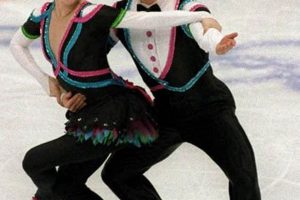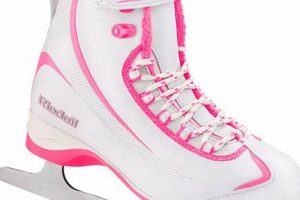These specialized ice skates are designed for figure skating, offering support and performance capabilities tailored to the demands of the sport. These skates commonly feature a layered leather boot construction providing structure and ankle support, and a high-quality blade attached to the sole for executing precise maneuvers.
The specific design elements of these ice skates are crucial for skaters aiming to learn and perfect increasingly complex jumps, spins, and footwork sequences. The boot’s rigidity supports proper alignment, while the blade’s profile and rocker facilitate controlled edges and smooth transitions. Historical context reveals a continuous evolution in skate technology, driven by advancements in materials and a deeper understanding of biomechanics in figure skating.
A comprehensive understanding of ice skate selection, maintenance, and fitting is vital for skaters of all skill levels. The subsequent sections will delve into these key areas, providing detailed information to optimize skating performance and enjoyment.
Essential Guidance
Optimal performance relies on selecting the appropriate equipment and ensuring consistent maintenance. The following guidance aids in maximizing skating potential.
Tip 1: Proper Sizing is Paramount: Accurate foot measurement is crucial. Ill-fitting footwear hinders performance and increases the risk of injury. A professional fitting ensures the appropriate size and width.
Tip 2: Prioritize Professional Blade Mounting: Correct blade positioning is vital for balance and edge control. A qualified technician should mount the blade to ensure proper alignment relative to the boot.
Tip 3: Regular Blade Sharpening is Necessary: Sharp edges are essential for controlled skating. The frequency of sharpening depends on usage, but regular inspection is recommended. Dull blades compromise performance and safety.
Tip 4: Consistent Boot Maintenance Extends Lifespan: After each use, thoroughly dry the boots, both inside and out. Use boot covers to protect the leather from scuffs and moisture. Regular cleaning prevents deterioration and prolongs durability.
Tip 5: Monitor Blade Screws for Tightness: Periodically check the screws securing the blade to the sole. Loose screws can affect stability and require immediate attention to prevent accidents.
Tip 6: Break-In Period is Essential: New boots require a break-in period to conform to the skater’s foot. Short, regular skating sessions are recommended to gradually soften the leather and avoid discomfort.
Tip 7: Seek Expert Advice for Upgrades: As skill level progresses, upgrading to more advanced models might be necessary. Consult with a knowledgeable professional to determine the appropriate model based on skating needs and goals.
Adhering to these recommendations promotes enhanced performance, extends equipment lifespan, and ensures a safer skating experience. Prioritizing these aspects is a sound investment in skating development.
Following these essential practices will greatly improve the longevity and performance of skating equipment. The concluding section summarizes key considerations for skaters.
1. Ankle Support
Ankle support is a critical determinant in the performance and safety of figure skaters utilizing ice skates. It provides the necessary stability and control for executing complex maneuvers, influencing jump landings, spins, and footwork accuracy. The design and construction of figure skating footwear are specifically engineered to provide varying degrees of this support, tailored to different skill levels and skating disciplines.
- Boot Stiffness and Support Levels
Boot stiffness directly dictates the level of ankle support offered. Entry-level skates possess a softer boot allowing greater flexibility, suitable for beginners learning basic skills. As skaters progress, they require stiffer boots, providing increased support for more demanding jumps and spins. Advanced-level models incorporate reinforced materials and construction techniques to maximize ankle stabilization, preventing excessive pronation or supination during high-impact landings.
- Material Composition and Construction
The materials used in boot construction significantly contribute to ankle support. Leather remains a traditional choice, offering a balance of support and moldability. Synthetic materials, such as composite polymers, are increasingly used for their lightweight properties and ability to be precisely molded for enhanced support. The layering and stitching techniques employed also impact rigidity; multiple layers of leather or synthetic reinforcement in key areas provide targeted support.
- Lacing Systems and Fit
The lacing system plays a crucial role in customizing ankle support. A well-designed lacing system allows skaters to adjust the tightness around the ankle and lower leg, providing a secure and supportive fit. Hooks and eyelets strategically placed along the boot enable precise control over pressure distribution. Improper lacing techniques can compromise support, leading to instability and potential injury. A proper fit, achieved through professional fitting, is paramount for maximizing the effectiveness of the lacing system.
- Injury Prevention and Rehabilitation
Adequate ankle support is essential for preventing ankle injuries common in figure skating, such as sprains and strains. The stability provided by the boot helps absorb impact forces and maintain proper alignment. Furthermore, specific models are designed with features to address skaters with pre-existing ankle issues or those recovering from injuries. These features may include additional padding, adjustable straps, or customized orthotics to provide targeted support and facilitate rehabilitation.
The degree and type of ankle support integrated into these specialized skates directly correlate with the skater’s skill level, training regimen, and individual needs. The interplay of boot stiffness, material composition, lacing systems, and proper fit determines the effectiveness of ankle support in optimizing performance and mitigating the risk of injury. Continuous advancements in design and materials aim to provide skaters with increasingly sophisticated and personalized support solutions.
2. Blade Quality
Blade quality significantly influences the performance characteristics of ice skates used in figure skating. This component is integral to the execution of jumps, spins, and intricate footwork. The composition, design, and manufacturing precision of the blade directly affect a skater’s ability to maintain edges, control speed, and achieve the necessary precision for complex maneuvers. For instance, a higher-quality blade, often made from high-carbon steel, retains its edge sharpness longer, providing a more consistent feel and reducing the frequency of sharpening.
The rocker profile of the blade, the curvature along its length, also determines the skater’s agility and balance. A more pronounced rocker allows for quicker turns and facilitates spins, while a flatter profile provides greater stability for gliding. The presence of a properly defined ‘sweet spot’ on the blade, the area where the skater finds optimal balance and control, is crucial for consistent jump landings. Inadequate blade quality can result in inconsistent edge control, difficulty maintaining speed, and compromised jump execution, increasing the risk of falls and hindering skill development. The choice of blade should align with the skater’s skill level and the demands of their routine.
Therefore, selecting equipment with superior blade quality constitutes a crucial investment in a figure skater’s training and performance. Prioritizing this aspect minimizes the impact of equipment limitations on skill acquisition and maximizes potential for success in the sport. Compromises in blade quality can lead to increased frustration and decreased confidence, ultimately affecting the skater’s overall experience and progression. The blade serves as a direct interface between the skater and the ice; its quality directly translates to the skater’s ability to express their skill and artistry.
3. Proper Fit
The relationship between proper fit and figure skates is crucial for performance, safety, and long-term development. Incorrect sizing or fit compromises stability, hindering the execution of complex maneuvers and increasing the risk of injury. This is particularly relevant to figure skates, where precise control over edges and body alignment is paramount. A boot that is too large allows excessive movement, making it difficult to maintain balance and control, while a boot that is too small restricts circulation and causes discomfort, affecting the skater’s ability to perform. An example would be a skater attempting a double axel in improperly fitted footwear; the instability could lead to a fall and potential ankle injury. Therefore, proper fit is an essential component for these skates, contributing directly to the skater’s ability to progress and reducing the likelihood of setbacks due to ill-fitting equipment.
Achieving this optimal fit requires a comprehensive approach, involving precise foot measurement, consideration of foot width, and potentially custom adjustments. The process often necessitates professional assistance from trained fitters who can assess the skater’s foot characteristics and recommend the appropriate size and model. Furthermore, the fit may need adjustments during the break-in period as the boot conforms to the skater’s foot. Skaters with unique foot shapes may benefit from heat molding or custom orthotics to achieve a more personalized and comfortable fit, enhancing both performance and reducing the risk of blisters or other foot-related issues. Maintaining the correct fit is an ongoing consideration, as the skater’s foot may change over time due to growth or changes in training intensity.
In summary, prioritizing proper fit represents a critical investment in a figure skater’s overall development and well-being. Overlooking this aspect can lead to performance limitations, discomfort, and increased risk of injury. While achieving the ideal fit may require professional assistance and potentially custom adjustments, the benefits of enhanced stability, control, and comfort far outweigh the effort. Therefore, a focus on proper fit is not merely a matter of preference but rather an essential element for skaters seeking to maximize their potential and enjoy a safe and rewarding skating experience.
4. Maintenance Schedule
The longevity and performance of figure skates are directly contingent upon adherence to a consistent maintenance schedule. Figure skates, in particular, require diligent care due to the rigorous demands placed upon them during training and performance. Neglecting routine maintenance can lead to diminished performance capabilities, increased risk of injury, and premature equipment failure. For example, moisture left on the blade after skating will cause rust, degrading the edges essential for precise movements. Similarly, dirt and debris accumulating on the boot’s exterior can damage the leather or synthetic materials, compromising its structural integrity and support. A well-structured maintenance schedule mitigates these issues, ensuring that the skates remain in optimal condition for an extended period.
The practical implications of a comprehensive maintenance schedule extend beyond mere equipment preservation. Regularly sharpening the blades ensures clean, controlled edges, enabling skaters to execute jumps, spins, and footwork sequences with greater accuracy and confidence. Proper boot maintenance, including drying and cleaning, preserves the boot’s structural integrity, providing the necessary ankle support for stable landings and precise movements. Furthermore, routinely inspecting and tightening blade screws prevents instability, minimizing the risk of accidents. The time invested in preventative maintenance translates into enhanced performance, reduced injury risk, and increased training consistency. Skaters who prioritize this facet of their equipment management are more likely to experience sustained progress and long-term success in the sport.
In conclusion, the maintenance schedule is not merely a supplemental aspect of figure skating equipment, but an integral component directly impacting performance, safety, and longevity. While the specific tasks may vary depending on the skate model and skating frequency, the underlying principle of consistent care remains paramount. Addressing the challenges of time constraints and competing priorities necessitates a proactive approach, integrating maintenance into the skater’s regular training routine. The commitment to proper equipment care reflects a broader dedication to the sport, optimizing the skater’s ability to achieve their full potential and minimize the risks associated with inadequate equipment maintenance.
5. Skill Level
The correlation between a figure skater’s skill level and the appropriate ice skate model is significant. Beginner skaters require equipment offering flexibility and support for basic skills, whereas advanced skaters necessitate models designed for the high-impact demands of complex jumps and spins. Choosing equipment incongruent with one’s skill level can impede progress and increase the likelihood of injury. For example, a novice skater using a boot designed for triple jumps may struggle with fundamental edge control due to excessive stiffness, while an advanced skater utilizing a beginner model will find insufficient support for advanced techniques. The design characteristics of figure skates, including blade curvature, boot stiffness, and overall support structure, are specifically tailored to accommodate the biomechanical demands of various skill levels.
Real-world examples illustrate the practical implications of this connection. A skater transitioning from single jumps to double jumps typically requires a boot with increased ankle support to stabilize landings. Similarly, skaters specializing in spins may benefit from a blade with a smaller rocker radius, facilitating quicker rotations. Coaches and professional fitters play a crucial role in assessing a skater’s skill level and recommending appropriate equipment. This assessment considers factors such as the skater’s training regimen, jump repertoire, and individual biomechanics. Proper skate selection, guided by skill level, optimizes performance and minimizes the risk of injury, allowing skaters to progress efficiently and safely.
In conclusion, understanding the connection between skill level and equipment choice is paramount for figure skaters of all levels. This understanding ensures that equipment aligns with current abilities and supports future development. Neglecting this alignment can result in impaired progress, increased injury risk, and diminished enjoyment of the sport. While personal preferences and budget considerations may influence equipment decisions, prioritizing skill level as a primary factor facilitates effective progression and maximizes the benefits of training and practice. The challenge lies in continuous assessment and equipment upgrades as the skater’s abilities evolve.
6. Boot Stiffness
Boot stiffness constitutes a critical design element in figure skates, directly impacting a skater’s ability to execute various techniques and maintain control on the ice. Within the context of ice skates, boot stiffness determines the level of support provided to the ankle, influencing stability, jump landing mechanics, and overall performance. The boot stiffness should be carefully considered to match the skater’s skill level and the demands of their training regimen.
- Role in Ankle Support and Stability
Boot stiffness plays a fundamental role in providing ankle support. A stiffer boot offers greater resistance to ankle flexion and extension, promoting stability during jumps and landings. This is particularly crucial for advanced skaters performing complex aerial maneuvers where precise control is essential. Conversely, a softer boot allows for greater ankle flexibility, which may be preferred by beginners focusing on developing basic skating skills and edge control. Excessive ankle movement within the boot can lead to instability and increase the risk of injury.
- Impact on Jump Mechanics
The stiffness of the boot significantly affects a skater’s ability to generate power and control during jump takeoffs and landings. Stiffer boots facilitate efficient energy transfer, allowing skaters to spring higher and maintain proper alignment. Upon landing, the boot’s rigidity helps absorb impact forces and stabilize the ankle, reducing the risk of sprains or fractures. Improper boot stiffness can compromise jump height, landing stability, and overall jump technique.
- Influence on Edge Control and Footwork
Boot stiffness also influences a skater’s ability to control edges and execute intricate footwork sequences. A stiffer boot provides enhanced responsiveness to subtle shifts in weight and pressure, allowing for precise edge control. This is particularly important for performing turns, spirals, and other edge-based maneuvers. Softer boots may offer greater flexibility for certain footwork patterns, but can compromise stability and control at higher speeds or during complex edge work.
- Correlation with Skill Level and Skating Style
The optimal boot stiffness varies depending on the skater’s skill level and skating style. Beginner skaters typically benefit from softer boots that promote ankle flexibility and facilitate the development of basic skills. Intermediate skaters may require boots with moderate stiffness to support more advanced jumps and spins. Advanced skaters often prefer stiffer boots that provide maximum support and responsiveness for high-level techniques. Furthermore, skaters specializing in different disciplines, such as freestyle or ice dance, may have varying preferences for boot stiffness based on the specific demands of their discipline.
The selection of appropriate boot stiffness is a critical aspect of equipment fitting, requiring careful consideration of the skater’s skill level, training goals, and biomechanical characteristics. While stiffer boots offer enhanced support and responsiveness for advanced techniques, they may be detrimental to beginners who require greater ankle flexibility. Conversely, softer boots may be beneficial for developing basic skills but can compromise stability and control for advanced skaters. Consulting with a qualified skate technician or coach is essential for determining the optimal boot stiffness to maximize performance and minimize the risk of injury.
Frequently Asked Questions
The following section addresses common inquiries regarding specialized figure skating equipment. The information presented aims to clarify critical considerations related to selection, maintenance, and performance.
Question 1: What is the expected lifespan of figure skating boots?
The lifespan varies depending on usage frequency, skill level, and maintenance practices. Generally, boots may last from one to three years for competitive skaters, while recreational users may experience a longer lifespan. Regular maintenance is crucial to extending the usable life.
Question 2: How often should figure skate blades be sharpened?
Sharpening frequency depends on ice time, skating style, and blade quality. Professional skaters often require sharpening every few weeks, while recreational skaters may only need sharpening a few times per year. Dull blades compromise performance and safety.
Question 3: What are the key indicators of improper figure skate fit?
Indicators include heel slippage, toe cramping, and excessive movement within the boot. Ill-fitting equipment can lead to blisters, discomfort, and impaired performance. Professional fitting is recommended to ensure accurate sizing and optimal support.
Question 4: How does boot stiffness affect skating performance?
Boot stiffness dictates ankle support, influencing jump stability and edge control. Softer boots are suitable for beginners, while stiffer boots are necessary for advanced skaters executing complex maneuvers. The appropriate stiffness level depends on skill and training intensity.
Question 5: What are the essential steps for maintaining figure skate blades?
Essential steps include drying blades immediately after use, storing them with soakers, and regularly inspecting for rust or damage. Proper blade maintenance prevents corrosion and preserves edge quality.
Question 6: Can figure skates be used for recreational ice skating?
While these ice skates can be used for recreational skating, their design is specifically optimized for figure skating techniques. Recreational skates may offer greater comfort and are generally more affordable for casual use. Consider skill level and skating goals when selecting equipment.
The answers provided offer a concise overview of common concerns. Consulting with experienced professionals remains a valuable resource for individualized guidance.
The following section will explore the historical evolution of figure skating equipment.
Concluding Remarks
This exposition has clarified the multifaceted nature of “jackson ultima figure skates,” emphasizing the interconnectedness of proper fit, blade quality, maintenance, boot stiffness, and skill level. The presented information underscores the importance of informed decision-making when selecting and maintaining this specialized equipment. Each element plays a crucial role in optimizing performance, ensuring safety, and extending the lifespan of the equipment.
As figure skating evolves, so too will the technology underpinning its essential equipment. Continuous advancement in materials and design promises to further enhance the performance capabilities and safety features of figure skates. A commitment to informed equipment practices remains vital for skaters striving to achieve their full potential in this demanding and artistic discipline.







